【配套K12】八年级英语下册Unit1教案
- 格式:doc
- 大小:36.00 KB
- 文档页数:21
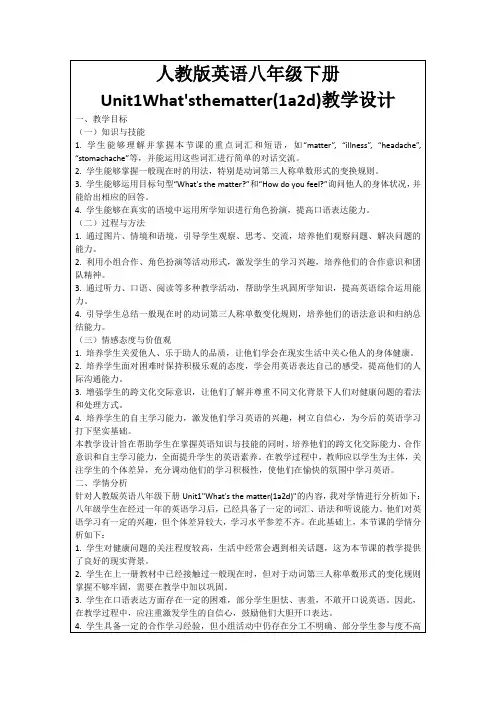
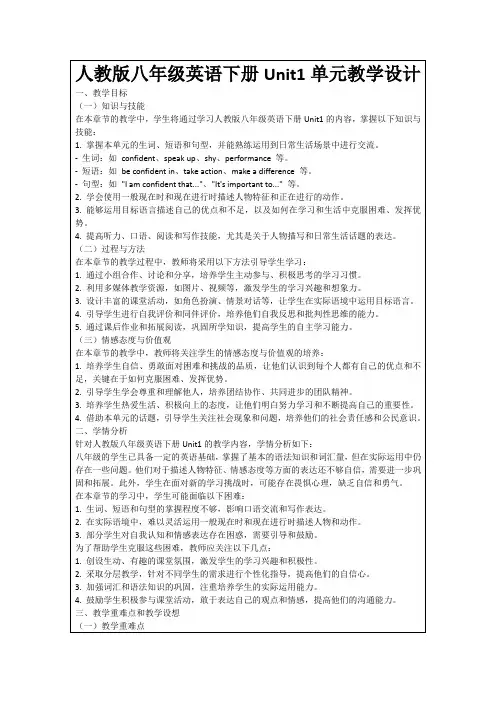
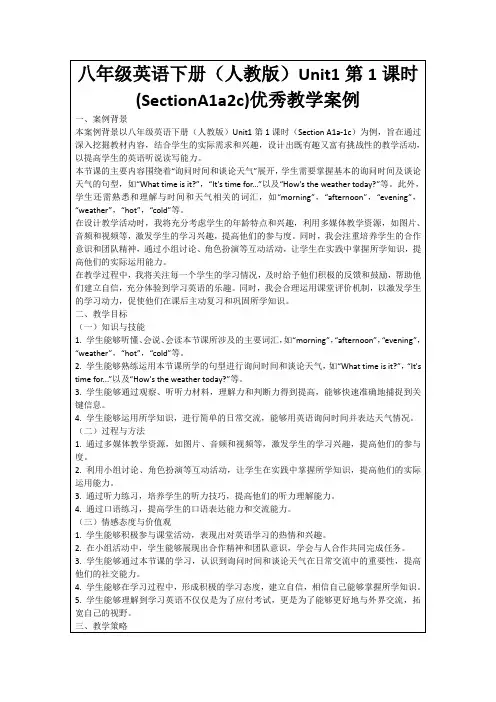
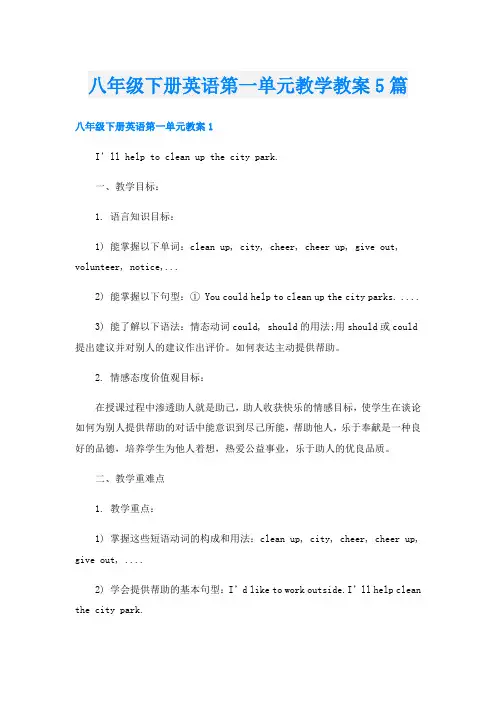
八年级下册英语第一单元教学教案5篇八年级下册英语第一单元教案1I’ll help to clean up the city park.一、教学目标:1. 语言知识目标:1) 能掌握以下单词:clean up, city, cheer, cheer up, give out, volunteer, notice,...2) 能掌握以下句型:① You could help to clean up the city parks. ....3) 能了解以下语法:情态动词could, should的用法;用should或could 提出建议并对别人的建议作出评价。
如何表达主动提供帮助。
2. 情感态度价值观目标:在授课过程中渗透助人就是助己,助人收获快乐的情感目标,使学生在谈论如何为别人提供帮助的对话中能意识到尽己所能,帮助他人,乐于奉献是一种良好的品德,培养学生为他人着想,热爱公益事业,乐于助人的优良品质。
二、教学重难点1. 教学重点:1) 掌握这些短语动词的构成和用法:clean up, city, cheer, cheer up, give out, ....2) 学会提供帮助的基本句型:I’d like to work outside.I’ll help clean the city park.2. 教学难点:学会提供帮助的基本句型三、教学过程Period 1(Section A 1a-2d)Step 1 Warming up1. 播放学生志愿者进行义务帮助别人的活动视频,通过询问他们以下问题来引导学生们了解社会上一些的志愿们进行的活动。
Step 2 New words Read new words on p9-10.Step 3 Discussion1. 1a. Look at the ways you could help others. Then list other ways.2. Ss discuss with their partners and write the ways one could help others:① Help plant trees by the river. ② Help clean up the city park.③ Visit the old people in the old people’s home. ④ Help young kids to learn English.Step 4 Listening1. T: Tell Ss to read the sentences in the chart. Make sure they know the meaning of the sentences.2. 1b. Play the recording for the Ss to listen and number the ways the boy and girl could help others.Step 5 Pair work1. Let Ss read the conversation in the picture.2. 1c. Use the information in the chart of 1b to make other conversations.A: I hope to work outside.B: You could help to clean up the city parks. ........3. Let some pairs act out their conversations.Step 6 Listening1. 2a:T: A group of students are planning a City Park Clean-up Day. Listen and check (√) the things they are going to do to tell people about it.1. Look at the pictures in 2a. Discuss the things they are going to do.2. Play the recording for the Ss to listen and check the pictures.3. Play the recording again to check the answers.2. 2b:1. Let Ss read the sentences below. Explain some main sentences for the Ss. Make sure they know what to do.2. Play the recording for the Ss to write the correct words in the blanks.3. Play the recording again to check the answers.Step 7 Pair work1. 2c. Tell Ss to make a conversation using the information in 2a and 2b.2. Let one pair to read out thei r conversation first.e.g. A: We need to come up with a plan for the City Park Clean-Up Day.B: Let’s have lunch first.A: No, we need to start now. Clean-Up Day is only two weeks from now.B: You’re right. We can’t put off making a plan. As we talk, I’ll write down all our ideas. Then we can decide which ideas are best.A: Let’s make some notices, too. Then I’ll hand them out after school.B: And we could each call up ten students and ask them to come.3. Ss act the conversation in pairs. Ask some pairs to act out their con versations.Step 8 Reading and Role-play1. Read the conversations and answer the two questions:① Where’s Helen going to work this summer?__________________________________② What did Tom do to help the old people?____________________________________Answers: She’s going to work in an old people’s home.Reading the newspaper or just talking to the old people.2. Read the conversation after the teacher.3. Practice the conversation with their partner. Then let some pairs to act out the conversation.Homework:Teaching thought:Period 2(Section A 3a-3c)Step 1 Revision1. Write down the phrases.1. 打扫 ________2. 分发 ________3. 曾经 _______4. (使)变得高兴 ________5. 义务做某事 _________________6. 大打扫日 ______________7. 想出主意(办法)____________2. Role-playA: Hi, Tom. I’m making some plans to work in an old people’s home this summer.B: Really? I did that last summer!Step 2 New words Read new words on p11.Step 3 Reading1.Tell Ss to read the article in 3a quickly and try to find the answers to these questions:1. What does Mario love?2. What does Mary love?3. What do Mario and Mary volunteer to do?Ss read the article quickly and try to answer the questions:Answers: 1. He loves animals.2. She loves reading books.3. Mario volunteers at animal hospital and Mary helps kids learn to read.2.3b: Read the article again and answer the questions.1. Why does Mario volunteer to help others?2. Why does Mary volunteer to help others?3. What does Mario say about volunteering?4. What does Mary say about volunteering?Answers: 1. Because he believes it can help him to get his future dream job.2. Because she can do what she loves to do and help others.3. He gets such a strong feeling of satisfaction when he sees the animals get better and the look of joy on their owners’ face.4. Volunteering is a dream come true for her.Homework Make sentences with these words.help (to) do; want to do; learn to do; decide to do; how to do; volunteer to doTeaching thought:Period 3(Grammar Focus-4c)Step 1 RevisionComplete the sentences.Mario and Mary ____ ___ several hours each week __ ____ others. Mario wants __ ___ an animal doctor. He _________ at an animal hospital. He wants __ _____ more about ____ __ care for animals.Mary is a book lover. She could read by herself __ ___ ____ of four. Last year, she decided __ ___ ___ for a volunteer after-school _______ program. Mary still works there once a week __ ____ kids _____ __ read. Volunteering here is a dream come true for her. She can what she _____ ___ ___and helps others at the same time.Can you tell something about Mary to us?Answers: give up, to help, to be, volunteers, to learn, how to, at the age, to try out, reading, to help, learn to, loves to do Step 2 Grammar focus1. 阅读Grammar Focus中的句子,然后做填空练习。
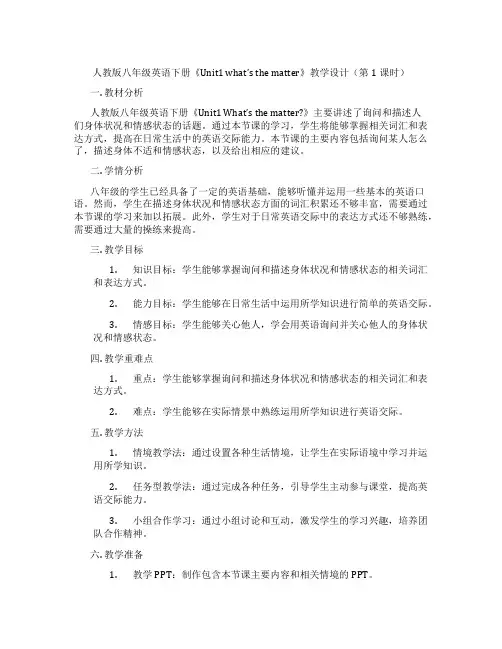
人教版八年级英语下册《Unit1 what’s the matter》教学设计(第1课时)一. 教材分析人教版八年级英语下册《Unit1 What’s the matter?》主要讲述了询问和描述人们身体状况和情感状态的话题。
通过本节课的学习,学生将能够掌握相关词汇和表达方式,提高在日常生活中的英语交际能力。
本节课的主要内容包括询问某人怎么了,描述身体不适和情感状态,以及给出相应的建议。
二. 学情分析八年级的学生已经具备了一定的英语基础,能够听懂并运用一些基本的英语口语。
然而,学生在描述身体状况和情感状态方面的词汇积累还不够丰富,需要通过本节课的学习来加以拓展。
此外,学生对于日常英语交际中的表达方式还不够熟练,需要通过大量的操练来提高。
三. 教学目标1.知识目标:学生能够掌握询问和描述身体状况和情感状态的相关词汇和表达方式。
2.能力目标:学生能够在日常生活中运用所学知识进行简单的英语交际。
3.情感目标:学生能够关心他人,学会用英语询问并关心他人的身体状况和情感状态。
四. 教学重难点1.重点:学生能够掌握询问和描述身体状况和情感状态的相关词汇和表达方式。
2.难点:学生能够在实际情景中熟练运用所学知识进行英语交际。
五. 教学方法1.情境教学法:通过设置各种生活情境,让学生在实际语境中学习并运用所学知识。
2.任务型教学法:通过完成各种任务,引导学生主动参与课堂,提高英语交际能力。
3.小组合作学习:通过小组讨论和互动,激发学生的学习兴趣,培养团队合作精神。
六. 教学准备1.教学PPT:制作包含本节课主要内容和相关情境的PPT。
2.教学素材:准备一些描述身体状况和情感状态的图片或卡片。
3.教学录音设备:用于播放听力材料。
七. 教学过程1.导入(5分钟)教师通过播放一段关于人们描述身体状况和情感状态的听力材料,引导学生关注本节课的主题。
同时,教师可以提问学生:“Can you guess what’s the matter with them?”,激发学生的学习兴趣。
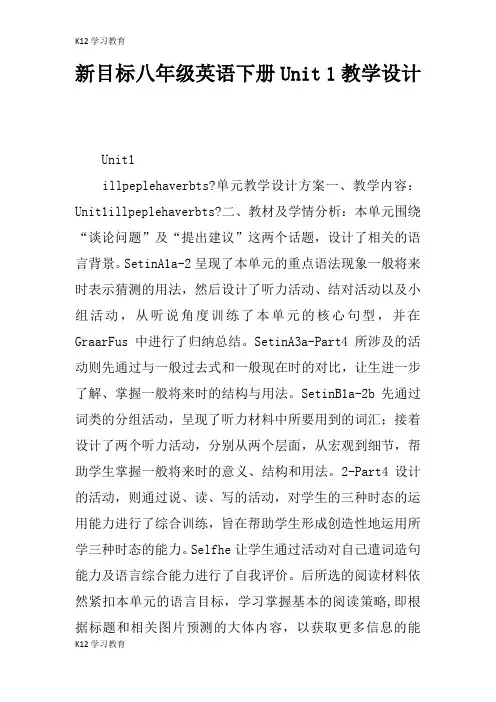
新目标八年级英语下册Unit 1教学设计Unit1illpeplehaverbts?单元教学设计方案一、教学内容:Unit1illpeplehaverbts?二、教材及学情分析:本单元围绕“谈论问题”及“提出建议”这两个话题,设计了相关的语言背景。
SetinA1a-2呈现了本单元的重点语法现象一般将来时表示猜测的用法,然后设计了听力活动、结对活动以及小组活动,从听说角度训练了本单元的核心句型,并在GraarFus中进行了归纳总结。
SetinA3a-Part4所涉及的活动则先通过与一般过去式和一般现在时的对比,让生进一步了解、掌握一般将来时的结构与用法。
SetinB1a-2b先通过词类的分组活动,呈现了听力材料中所要用到的词汇;接着设计了两个听力活动,分别从两个层面,从宏观到细节,帮助学生掌握一般将来时的意义、结构和用法。
2-Part4设计的活动,则通过说、读、写的活动,对学生的三种时态的运用能力进行了综合训练,旨在帮助学生形成创造性地运用所学三种时态的能力。
Selfhe让学生通过活动对自己遣词造句能力及语言综合能力进行了自我评价。
后所选的阅读材料依然紧扣本单元的语言目标,学习掌握基本的阅读策略,即根据标题和相关图片预测的大体内容,以获取更多信息的能力,从而让语篇教学成为实现情感态度与价值观目标的有效载体,通过描述未来,调动学生学习积极性,发挥想象力,帮助其树立正确的人生观和价值观:只有付出,才有收获。
八年级上Unit3hatareudingfrvaatin?Unit10I’gingtbeabasetballplaer已经学习了一般将来时,学生已经学会用现在进行时谈论未来的计划,用begingt句型谈论未来的打算。
本单元教材继续学习一般将来时,是上册教材的拓展和延续,即用ill接动词原形来表示将来要发生的动作,让学生学会预测未来,从语法层面上来讲应该顺理成章。
上册教材后语法的渗透也为学生学习本单元内容做了有益的铺垫。
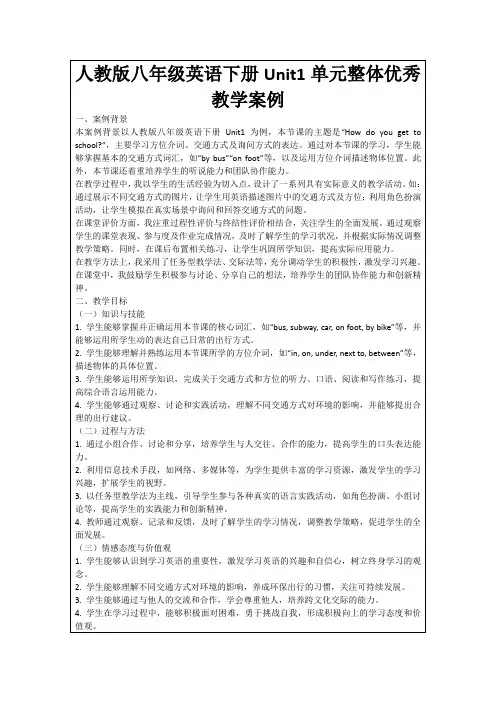

XX八年级英语下册unit1课时集体备课教案(新教材)课题Unit1SectionA课型N总课时1主备人王惠授课日期审核人主讲人教学目标:Learntodescribeandtalaboutthehealthproblesandaccide nts.Enablestudentstotalabouthealthproblesandgiveadvicei ththelanguagepoints.Studentscareoreabouttheselvesandtheirfailyebers’health.教学重点难点:Learnandasterthepartsofthebody,thenaesoftheillnessa ndtheexpressionsofgivingadvice.Structure:①havea+thenaesoftheillness②should+verb教学流程及教学内容个案补充Step1aring-upSingtheEnglishsongIfyou’rehappy.Step2PresentationT:Thisisreallyabeautifulsong.hatcanyoudoifyouarehappy?Ss:clapourhandsandstapourfeet.T:yes.Handsandfeetarepartsofourbody;doyounootherpar tsofourbodyinEnglish?Ss:Eye,head…T:you’regreat.Today,let’slearnthenaesoftheebodyparts.Theteachertouchesthepartsofthebodyonebyoneandsaysth e.hileteachingeachone,letstudentstouchorshoit.PresentapictureofPanchangjiangonthescreen.Letstuden tssayeachpartofthebody.oronSectionA1a.Playthegae:Touchthepartsofyourbody.Lettheholeclasst ouchthepartsoftheirbodyhenteachersay:Touchyour…Aseightstudentstoetothefrontanddoastheteachertellst he:Touchyour…Ifonedoesrong,lethiorhergobac,thelastoneho’sinthefrontistheinner.Step3PresentationandPracticeTheteacherieshavingastoachacheithanactionoftouching hisstoach,andass,“hat’stheatter?”,thensays,“I’notfeelingell,Ihaveastoachache.”Thenshosoepicturesonthescreenandasstudentstopractic e.Havestudentslooatthepictureandas:hatcanesaytohi?Ss:hat’stheatter?T:yes.Andhatshouldtheboysay? Letstudentsrepeatithotherpicturesaboutotherillness.Assoestudentstousegesturestoshotheillness,andhaveot herstoguess.aeaodeldialogue.T:hat’stheatterithhi?Ss:Hehasaheadache.Letstudentspracticeotherillness.A:hat’stheatter?B:He/Shehasaheadache/toothache/asorebac/asorethroat /acoldandacough.Shootherpictures,andasstudentstotalabouthealthprobl esofthepersonsinthepicturesinpairs.Step4ListenandSaoronSectionA1b,listenandnuberthenaes[1-5].Havestudentsorinpairsaccordingto1candassoepairstoac touttheirconversations.Step5Presentationoringroups,andhavestudentsrole-playbeteenadoctorand apatient.Asthetotalaboutthehealthproblesandgiveadvi ceingroups.Step6PracticeDo2a.Havestudentslistenandnuberthepicture[1-5]inthe ordertheyhear.Thenchectheanser.Playthetapeagainfort hestudentsandletthedo2bbytheselves.Havestudentslistenagainandatchtheproblesiththeadvic e.Thenplayitagainandchectheansers.Do2c.Pairor.Letstudentsreadtheconversationsin2cfirs t.Thenorinpairs,aeaneconversationaccordingto2aand2b.Step7ExpansionandExtensionRole-playtheconversation.First,havestudentstorole-playtheconversationin2ding roupsandchoosethebest.Ingroups,studentsdiscussthelanguagepointsandsolveth eprobles.Theteacheralsaroundandgivesthesoehelpifthe yneed.Step8SuarAsstudentstosuupthepartsofabodyandthenaesofillness.Helpstudentstosuuphotogiveadvicebyusing“should”and“shouldn’t”,thenasthetogivetherightadviceaboutdifferentprob les.作业设计:Giveadvicetothefolloingproblesasuchaspossible:soret hroat,toothache,headache,cold.Thenchooseonetoaeadia logueithyourpartner.板书设计:Unit1hat’stheatter?hat’stheatter?Ihaveastoachache/sorethroat/acold.hat’stheatterithher/hi?She/Hehasaverysorethroat.hatshouldI/he/shedo?youshould/shouldn’t…教学反思:。
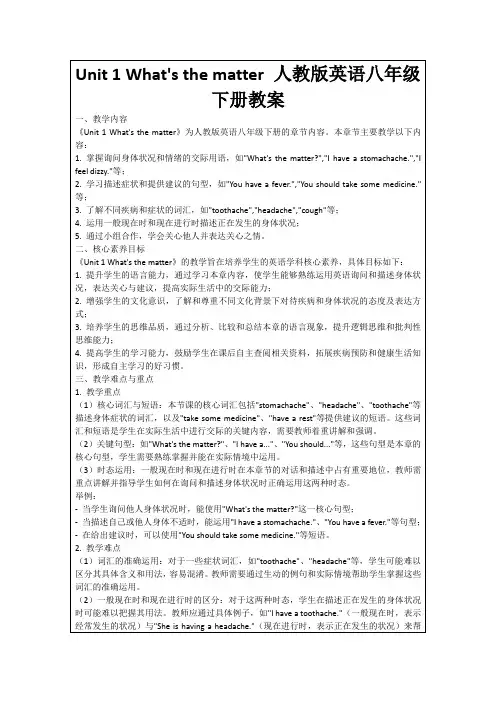
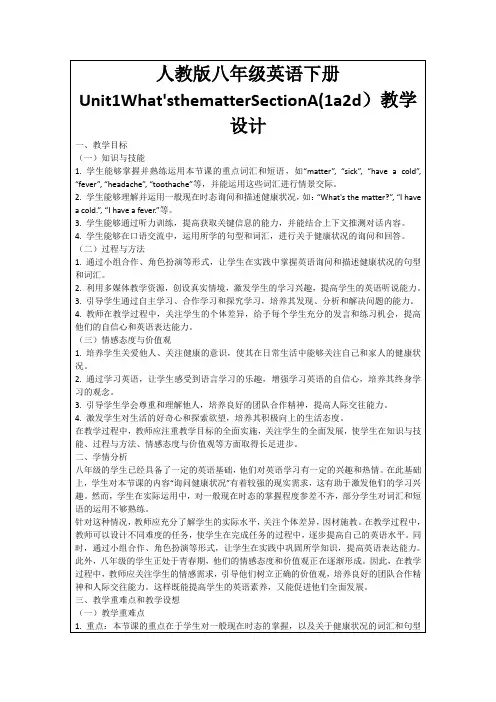
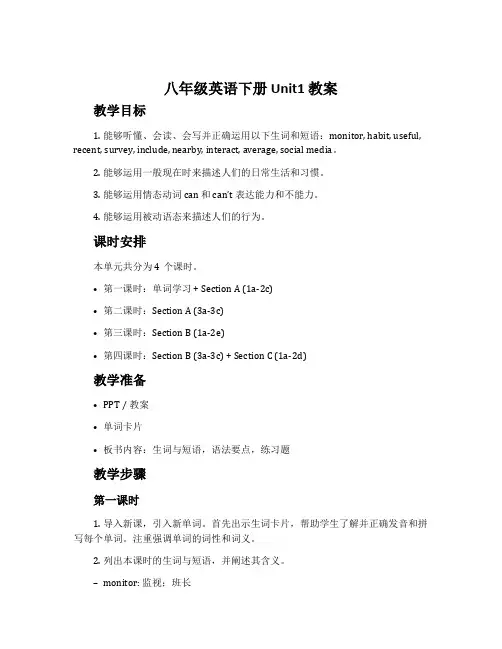
八年级英语下册 Unit1 教案教学目标1.能够听懂、会读、会写并正确运用以下生词和短语:monitor, habit, useful, recent, survey, include, nearby, interact, average, social media。
2.能够运用一般现在时来描述人们的日常生活和习惯。
3.能够运用情态动词 can 和can’t 表达能力和不能力。
4.能够运用被动语态来描述人们的行为。
课时安排本单元共分为4个课时。
•第一课时:单词学习 + Section A (1a-2c)•第二课时:Section A (3a-3c)•第三课时:Section B (1a-2e)•第四课时:Section B (3a-3c) + Section C (1a-2d)教学准备•PPT / 教案•单词卡片•板书内容:生词与短语,语法要点,练习题教学步骤第一课时1.导入新课,引入新单词。
首先出示生词卡片,帮助学生了解并正确发音和拼写每个单词。
注重强调单词的词性和词义。
2.列出本课时的生词与短语,并阐述其含义。
–monitor: 监视;班长–habit: 习惯–useful: 有用的–recent: 最近的–survey: 调查–include: 包括–nearby: 附近的–interact: 交流;相互作用–average: 平均–social media: 社交媒体3.学习 Section A (1a-2c)。
首先让学生扫描课文,了解文字内容。
然后让学生独立完成 1a 的听力任务,听音记录下抽查的学生们的问题。
接着展示问题,进行小组讨论。
最后播放录音,核对答案。
4.进一步学习 Section A。
让学生在 1b 的基础上进行听力任务,填写正确的信息,并让学生彼此核对答案。
然后带着问题一起听录音,完成 2a 和 2b 的内容。
5.小结本课时的重点内容,布置相关练习作业。
第二课时1.复习上节课的生词。
八年级下英语第一单元教案5篇八年级下英语第一单元教案5篇英语是印欧语系-日耳曼语族下的语言,由26个字母组合而成,英文字母渊源于拉丁字母,拉丁字母渊源于希腊字母,而希腊字母则是由腓尼基字母演变而来的。
英语是国际指定的官方语言(作为母语),也是世界上最广泛的第一语言,英语包含约49万词,外加技术名词约30万个,是词汇最多的语言,也是欧盟以及许多国际组织以及英联邦国家的官方语言,拥有世界第三位的母语使用者人数,仅次于汉语和西班牙语母语使用者人数。
以下是带来的八年级下英语第一单元教案内容,感谢您的阅读,希望能帮助到您!八年级下英语第一单元教案1一、指导思想以“英语课程标准”为宗旨,适应新课程改革的需要,面向全体学生,提高学生的人文素养,增强实践能力和创新精神。
正确把握英语学科特点,积极倡导合作探究的学习方式。
培养学生积极地情感态度和正确的人生价值观,提高学生综合素质为学生全面发展和终身发展奠定基础。
二、教材分析《新目标英语》八年级(下册),全书共有十个单元,另两个复习单元,每个单元都列出了明确的语言目标,主要的功能项目与语法结构,需要掌握的基本词汇,并分为A和B两部分。
A部分是基本的语言内容,B部分是知识的扩展和综合的语言运用。
每个单元还附有SELFCHECK部分,学生可用来自我检测本单元所学的语言知识。
本教材各单元话题灵活,贴近生活实际。
在本册书里要学习的一些语法知识点有:一般将来时、过去进行时、现在完成时、间接引语、时间状语从句、条件状语从句、反意疑问句等。
同时每个单元后都提供了一篇阅读文章,用以训练学生的阅读能力,扩大学生的阅读量。
三、具体目标1、要使学生受到听、说、读、写英语的训练,掌握最基础的语言知识和语言技能以及培养初步援用英语交际的能力;养成良好的外语学习习惯,掌握学习外语的基本方法;为进一步学习和运用英语打下扎实的基础。
2、使学生明确学习英语的目的性并且树立学习英语的自信心。
3、培养初步运用英语交际的能力和自学能力。
新目标英语八年级下Unit1Willpeoplehaverobots?教案SectionA课时Unit1本单元目标呈现:知识目标:学会使用表达数量。
学会一般将来时。
语言目标:作出预言。
能力目标:学会预测未来。
能谈论过去、现在和将来。
课前导学。
对表示数量的形容词比较级的运用:uch-ore/little-less修饰不可数名词;any-ore/fe-feer修饰可数名词。
如:IhopeIhave______freetie.Idon’tlietoeepbusy.A.oreB.lessc.anyD.uchIfthereare______trees,theairinourcityillbe___cleane r.A.less;oreB.ore;orec.ore;uchD.uch;oreIahappybecauseIhavehoeortodotodaythanyesterday.A.oreB.lessc.feD.feer我们以前还学过哪两种表将来的方式,你可以列出来吗?___________________________________________________ _______________。
___________________________________________________ ________________。
本单元我们要学习什么时态,你知道吗?请举两个例子。
___________________________________________________ _____________。
___________________________________________________ _____________。
课堂反馈。
I、翻译下列短语在人们家里在家用电脑学习将来一百年后更少的污染活到二百岁空闲时间赞同某人II、根据所给首字母和句子的意思填写正确的单词Thesedayseveryoneu__________puterstodoalotofthings.Idon’taithhi.Therearealotofbinourcity.Ihopethereillbeorertoorforusinthefuture.e’llhaveoref__________tietoplaysports.III、用所给词的正确形式填空.Thereareanyne_________inourcity.ecandotheorith_________oneyand________peoplethanthe ycan.aybeheantstogo_________.IbelievethatintenyearsIillorfor____________.Thereare_________ofpeopleontheground.There_______beanypaperboos.Everyoneillhaveboosonput ers.eallant_____________thefutureofourselves.heredoyouthinSally_____________tenyearsfrono?Theboy__________toNeyortodaysago,andhe’llbebacsoon.0.____youatschoolyesterdayevening?ehadanexcitingpar ty.1.Doeshealays_______________alone?Idon’tno.--hereisr.Lu?--I’notsure.______he_______inhisoffice?3.couldyouplease___________soesnacsfore?henIgroup,I_______________afaouspilot.yfriendLizoften___________herclothesonednesday.第二课时SectionAUnit1课前导学ill表示将来,用于一般将来时。
八年级英语下册Unit1教案Unitone复习提要一.用所给词的适当形式填空。
Theyhavealotoftallsince3yearsago.It’stofinishsuchadifficulttasinaveryshorttie.Toseestoorro.Butheisveryofthelife.ycousinsbothanttobegreatsothattheycanaethoseclear.TheyilltrytostoppeoplefroaingThatastronautasnotiththattruth..那个宇航员对那个令人不快的事实感到很不满意。
.Totaesfivedaysthatparrot==Tospendsfivedaystha tparrotsanyscientistsaretryingtoaerobots,it’sdifficultforthethis.eallnothatthefuturecanbediffficultandanynever caetrue.Toaputerprograerin7years.0.eshouldtryourbesttousepeopleandoneytodooreor.二.写出下列短语.三只电动牙刷three2。
太空站。
好几百只鹦鹉of4。
在未来the.形状不同的巨大的机器人robotsdifferent.实现梦想realizethedrea===aethedrea.驾飞船到月球totheoon.7.fallinloveith穿戴更随意些ore9。
Bethesaeas反义bedifferent0.活到200岁livetohundredyearsold.1.通过电脑在家学习studyathoe三.重点句型1havefundoingsth.【句型介绍】意为\"做某事有乐趣",其中havefun相当于enjoyoneself,表示过得愉快。
【句式比较】haveagood/nice/onderfultiedoingsth./ithsth.Didyouhaveagood/nice/onderfultievisitingthatcountry?访问那国家你们快乐吗?另表“做某事费力”havetrouble/difficulty/probles/ahardtiedoingsth./it hsth.【特别提醒】句中fun及trouble为不可数名词,前不能用冠词。
可用great、uch、alotof,lotsof等修饰。
习题1.it’sfuninthesea,ehadgreatfunthere.hatfuntheyhadthatauseentpar.Nonenoshatgreattroubleehadyourhouse..ehadfunplayingputergaes.我们玩电脑游戏很愉快。
英语中集体名词,如faily,class,tea等作主语时,若作为一个整体看,其后的谓语动词用单数;若强调其组成成员,谓语动词用复数。
类似还有police和the+形容词表一类人时yfailyisahappyone.yfailyareallatchingTV.在比较级中,要注意than后面人称代词的格。
)当句中的谓语动词是不及物动词时,than后代词用主格还是宾格,意思上通常没有区别。
如:HerunsfasterthanI/e.他跑得比我快。
Theygettoschoolearlierthane/useveryday.他们每天都比我们到校早。
)句中谓语动词是及物动词时,than后面人称代词用主格还是宾格在意思上就有差别了。
试比较:Ilieyouorethanhe.我比他更喜欢你。
Ilieyouorethanhi.你和他相比,我更喜欢你。
在比较句型中,than后面的谓语动词常常省略。
也可以用相应的助动词来代替与前面相同的谓语动词,以避免重复。
如:TodoesbetteratthelessonsthanI.汤姆功课比我好。
SheatelessthanIforbreafast.她早饭吃得比我少。
.不定式作定语时,应放在被修饰词的后面,一般指一个还没有发生的动作。
如:Doyouhaveanythingtosayaboutthis?有关这件事你有没有什么要说的?.you\'dbetter...是youhadbetter...的缩写形式。
hadbetter为固定短语,意为\"最好......\",后接动词原形,常用来提出建议或劝告,其否定形式是\"hadbetternot+动词原形\"。
you\'dbetternotstaytheretoolong.你最好别在那里呆得太久。
Such作形容词,意思是“如此的”“这样的”,修饰各种名词。
Such这样的。
如Itissuchbadeather.天气如此恶劣。
Such常和表示结果的that从句搭配,表示“如此….以至于…”如Itassuchahotdaythateallhadtostayathoe.Such…that…和so…that…都可用来引出一个结果状语从句。
由于such是形容词,所以that从句前有一个受such 修饰的名词;而so是副词,用以修饰形容词或副词,因此that从句前一般不出现名词。
如Theyaresuchind-heartedteachersthatpeopleinthevillag eallrespectthe.Theexaassodifficultthatanystudentsfailedtopassit.a)如名词是可数名词的单数形式,such和so位置不同:such+a/an+形容词+单数名词=so+形容词+a/an+单数名词即suchanicegirl=soniceagirlb)如果名词是不可数名词或名词复数,只可用such,不能用so.:such+形容词+不可数名词或复数名词,如:suchgoodeather,suchcleveridsc)如果被修饰的不可数名词被uch,little,或复数名词被any,fe等表示量的形容词修饰时,用so,不用such.语法要点一般将来时的用法:1)表示将要发生的动作或情况;2)不以人的意志为转移,肯定要发生的事情。
ThedayaftertoorroillbeNationalDay.后天是国庆日。
in/after:in是指以现在时间为起点的“在一段时间以后”。
也可以表示“在将来多少时间之内”,句子中的谓语动词要用一般将来时态,对此提问用hosoonafter常指以过去时间为起点的“一段时间之后”,所以它与过去时态连用。
当after指某个特定的未来时刻或日期之后,或指以将来某一时间为起点的若干时间之后时,它可以与将来时态连用。
用”begoingto+动词原形”也可表示将来时,表示将要发生的事,打算或决定要做的事。
ore,less,feer的用法区别:ore为any,uch的比较级,意为“更多”,可修饰可数与不可数名词。
Less是little的比较级,意为“更好,较少”,修饰不可数名词。
Feer是fe的比较级,意为“更少”,修饰可数名词复数。
【注意】fe,little表示否定“几乎没有”==hardlyany 或notany/notuch。
afe==severalalittle表示肯定“一点,几个”=abitof……。
ouldliesth意思为“想要某物“;ouldlietodo意思为“想要做某事”。
回答ouldlie句型的一般疑问句时,其肯定回答为“yes,please.”;否定回答“No,thans”或“I’dlie/loveto,but….”d)当little表示“年纪小的”时,可用such+little+名词。
单选题1.It________usnearlyaholedaytofinishtheor.edB.costc.tooD.spentThereis________aterinthejar,isthere?A.feB.littlec.afeD.alittleThisbasetis________thanthatone.youcancarrythelighto ne.A.oreheavierB.uchheavyc.uchheavierD.veryheavierIt’spolite________theold.eshouldlearnfroyou.A.ofyoutohelpB.foryoutohelpc.ofyouhelpingD.foryouhe lpingTherearethree________studentsintheirschool.A.thousandsofB.thousandofc.thousandsD.thousandThere________aniportanteetingthisafternoon.Allofyou shouldattendit.A.illhaveB.illbec.illholdD.has—________illyouebacfroyouror,Dad?—Inabouthalfanhour,dear.A.HolongB.Hooftenc.hattieD.HosoonThebossaestheorers________longhourseveryday.A.orB.toorc.orsD.oringehadfun________therobotsdoanydifferentindsofthings.A.toatchB.atchedc.atchingD.atches0.—illyouplease________dothat?—o,Ion’t.A.on’tB.notc.don’tD.can1.凯蒂不能参加运动会了。
itty____________________________________________taepartinthesportseeting.昨天有好几百人来我们学校参观。
______________________peoplecaetovisitourschoolyest erday.3.彼得在上海找到了一份工作,他不得不在那里独自生活。
PeterfindsajobinShanghai,sohehasto___________there_ __________.我们家乡的污染没有以前严重了。
Thereis______________inourhoetonthanbefore.十年后你会是什么样子?hat____________________________________________inte nyears?根据要求完成句子1.Thereillbeasportseetingthiseeend.There_________________________________beasportseeti ngthisee.2.IthinSallyillbeadoctorinfiveyears.______________________youthinSally______________________infiveyears?3.Thereillbefeerpeoplein100years.___________there___________feerpeoplein100years?4.Thereon’tbeanypaperoney.Thereillbe______________________oney.5.yclassatesoftenhelpelearnEnglish.yclassatesoften___________e___________yEnglish.从方框中选择合适的句子完成对话。